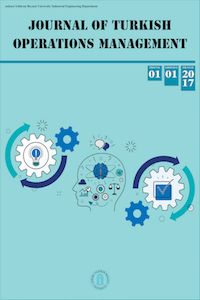Two-stage MCDM approach in the selection of manager training techniques
Two-stage MCDM approach in the selection of manager training techniques
Convenient management of the qualities of the managers who play effective and strategic roles in business decisions is very crucial. To develop and improve in terms of their managerial sense is significantly related to the training for the personnel who are nominated to be managers by the Human Resources (HR) department. The manager training techniques in the literature are divided into two main groups: on-the-job and off-the-job techniques. In this study, on-the-job manager training techniques which is highly important for the business and used for managers' training were evaluated. A two-stage integrated methodology was used to solve the problem. Hesitant Fuzzy Analytical Hierarchy Process (HF-AHP) was used to obtain criteria’ weights. The weights were included as an input to the MOORA method used to order training methods. The fact that the criteria affecting the choice of on-the-job training techniques cannot be distinguished from each other by certain lines and that it will be subjectively assessed has necessitated the inclusion of Hesitant Fuzzy LTS to the study. The criteria for the techniques were determined in the context of brainstorming conducted by HR experts and the authors.
Keywords:
Human Resource MCDM, Manager Training Techniques, Fuzzy,
___
- Brauers, W.K.M., and Zavadskas, E.K. “The MOORA Method and its application to privatization in a Transition Economy”, Control and Cybernetics, 35(2), 445-469, (2006).
- Chen, N., Xu, Z. “Hesitant fuzzy ELECTRE II approach: A new way to handle multi-criteria decision making problems”, Information Sciences, 292, pp. 175-197, (2015).
- Dağdeviren, M., İ. Yüksel, M. Kurt. “A fuzzy analytic network process (ANP) model to identify faulty behaviours risk (FBR) in work systems”. Safety Sciences, 46(771-783), (2008).
- Efil, İ. İşletmelerde Yönetim ve Organizasyon, Dora Yayınları, Bursa, Turkey, (2013).
- Esteban-Lloret, N.N., Aragón-Sánchez, A., and Carrasco-Hernández, A. “Institutional and competitive drivers on managers' training and organizational outcomes” BRQ Business Research Quarterly 17(4), pp. 242-258, (2014).
- Herrera, F., Martinez, L., and Rodríguez, R.M. “Hesitant fuzzy linguistic term sets”. Adv. Intel. Soft Computing. 122, 287–295, (2011).
- İşletmeciler, Mühendisler ve Yöneticiler için Operasyonel Yönetsel ve Stratejik Problemlerin Çözümünde Çok Kriterli Karar Verme, Edited by: Bahadır Fatih Yıldırım, Emrah Önder, Dora Yayıncılık, Bursa, Turkey, (2015).
- Jerez Gómez, P., Céspedes Lorente, J.J., Valle Cabrera, R. “Training practices and organisational learning capability: Relationship and implications”, Journal of European Industrial Training, 28, pp. 234-256, (2004).
- Karande, P., Zavadskas, E.K., Chakraborty, S. “A study on the ranking performance of some MCDM methods for industrial robot selection problems”, International Journal of Industrial Engineering Computations, 7(3), pp. 399-422, (2016).
- Li, Z.H. “An extension of the MULTIMOORA method for multiple criteria group decision making based upon hesitant fuzzy sets”, Journal of Applied Mathematics, (2014).
- Majumder, H., Maity, K. “Prediction and optimization of surface roughness and micro-hardness using grnn and MOORA-fuzzy-a MCDM approach for nitinol in WEDM”, Measurement: Journal of the International Measurement Confederation, 118, pp. 1-13, (2018).
- Rodriguez, R.M., Martinez, L., Herrera, F., “Hesitant fuzzy linguistic term sets for decision making”. IEEE Trans. Fuzzy System. 20 (1), 109–119. http://dx.doi.org/10.1109/TFUZZ.2011.2170076. (2012).
- Saaty, T. L. How to Make a Decision: The Analytic Hierarchy Process. European Journal of Operational Research, 48, 9-26, (1970).
- Stanujkic, D. “An extension of the moora method for solving fuzzy decision making problems”, Technological and Economic Development of Economy, 19, pp. S228-S255, (2014).
- Turabik, T., Atanur Baskan, G. S. Koçak, “Certain Developed Countries’ School Manager Training Models and in the Light of these Models Suggestions for Turkey's School Manager Training”, Procedia - Social and Behavioral Sciences, Volume 131, 15 May 2014, 236-243.
- Úbeda, M., “Training and business performance: The Spanish case.” Int. J. Hum. Resour. Manag. 16 (9), 1691-1710, (2005).
- Vlachos, I., “The effect of human resource practices on organizational performance: evidence from Greece.” Int. J. Hum. Resour. Manag. 19, 74-97, (2008).
- Yavuz, M., Oztaysi, B., Cevik Onar, S., and Kahraman, C. “Multi-criteria evaluation of alternative-fuel vehicles via a hierarchical hesitant fuzzy linguistic model.” Expert Syst. Appl. 42 (5), 2835–2848. http://dx.doi.org/10.1016/j.eswa.2014.11.010. (2015).
- Wang, C.Y., Wan, L., “Type-2 fuzzy implications and fuzzy-valued approximation reasoning”, International Journal of Approximate Reasoning 102, pp. 108-122, (2018).
- Wang, X.-K., Peng, H.-G., Wang, J.Q. “Hesitant linguistic intuitionistic fuzzy sets and their application in multi-criteria decision-making problems”, International Journal for Uncertainty Quantification, 8(4), pp. 321-341, (2018).
- Wang, W., Liu, X., Qin, Y. “A fuzzy Fine-Kinney-based risk evaluation approach with extended MULTIMOORA method based on Choquet integral”, Computers and Industrial Engineering, 125, pp. 111-123, (2018).
- Wei, G., Zhang, N. “A multiple criteria hesitant fuzzy decision making with Shapley value-based VIKOR method”, Journal of Intelligent and Fuzzy Systems, 26(2), pp. 1065-1075, (2014).
- Zadeh, L.A. Fuzzy sets, Information and Control,8(3), 338-353, (1965).
- Zhang, Q.-L., Liu, F., Fan, C.-Q., Xie, W.H. “Fuzzy numbers intuitionistic fuzzy descriptor systems”, Information Sciences 469, pp. 44-59, (2018).
- Zhang, X., Xu, Z. “Hesitant fuzzy multiple criteria decision analysis based on TOPSIS”, Studies in Fuzziness and Soft Computing, 345, (2017).
- ISSN: 2630-6433
- Başlangıç: 2017
- Yayıncı: Ankara Yıldırım Beyazıt Üniversitesi
